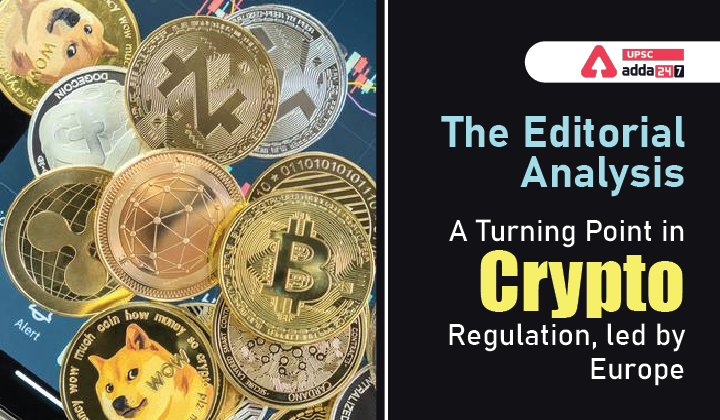Table of Contents
The Editorial Analysis- A Turning Point in Crypto Regulation, led by Europe
Relevance for UPSC Exam- Indian Economy and issues relating to planning, mobilization of resources, growth, development and employment.
Cryptocurrency in News
Finance Minister Nirmala Sitharaman’s answer to a question recently in Parliament about the Indian government’s stance on cryptocurrencies led to the speculation of a possible crypto ban in India.
What is Cryptocurrency?
- Any form of currency that exists digitally or virtually and designed to work as a medium of exchange.
- Individual coin ownership records are stored in a ledger existing in a form of a computerized database.
- It uses strong cryptography to secure transaction records, to control the creation of additional coins, and to verify the transfer of coin ownership.
- Not issued by a central authority, cryptocurrencies typically use decentralized system based on blockchain technology as opposed to central banking systems which makes it nearly impossible to counterfeit or double-spend.
- The first blockchain-based cryptocurrency was Bitcoin, which still remains the most popular and most valuable.
Significance
- It can help in keeping corruption in check by tracking the flow of funds and transactions due to its peer-to-peer network.
- Cryptocurrencies can help in saving money and substantial time for the remitter and the receiver, as it is conducted entirely on the Internet, runs on a mechanism that involves very less transaction fees and is almost instantaneous.
- Integrating blockchain into these sectors could result in hundreds of billions of dollars in savings.
Benefits
- Funds transfer between two parties will be easy and cheap without the need of third party like credit/debit cards or banks.
- Last few years have seen a sharp rise in the price of cryptocurrencies and due to this, cryptocurrencies can become a preferred investment destination.
- Due to the high demand for cryptocurrency its prices have largely remained on a growing trajectory as a result people tend to hold more cryptocurrency than spending it that may cause a deflationary effect on the currency.
Drawbacks
- Cryptocurrencies do not have any sovereign guarantee and hence are not legal tender posing risks to consumers.
- Being very speculative in nature cryptocurrencies are highly volatile.
- Losing the private key will lead to the loss of access to crypto (unlike traditional digital banking accounts, this password cannot be reset).
- Private keys are stored by technical service providers (cryptocurrency exchanges or wallets), which are prone to malware or hacking.
- The public keys engaging in a transaction cannot be directly linked to an individual which makes cryptocurrencies more vulnerable to criminal activity and money laundering. They provide greater anonymity than other payment methods as well.
- Central bank cannot regulate the supply of cryptocurrencies in the economy posing a risk to the financial stability of the country in case of widespread use.
- It may have adverse consequences for the country’s energy security (the total electricity use of bitcoin mining, in 2018, was equivalent to that of mid-sized economies such as Switzerland).
Europe’s approach
- The European market is second to the United States economically and behind Asia in terms of the number of Internet users and yet Europe is the global yardstick on technology regulations.
- The General Data Protection Regulation, or GDPR, first published in 2016 and implemented in 2018, marked a turning point on consumer data protection and privacy not just in Europe but the world over.
- The GDPR introduced a framework for seeking user consent and introduced several progressive rules such as the right to forget. The Supreme Court of India has also held that the right to privacy is a fundamental right and an integral part of the right to life and liberty.
- This June, amid all the attention over inflation and the related capital market turmoil, the European Parliament and Council, the legislative arms of the European Union, came to a provisional agreement on long-awaited regulations on crypto, namely, the Regulation of Markets in Crypto-Assets, or MiCA.
Path to regulate crypto assets-Europe’s way
- The Council presidency and the European Parliament reached a provisional agreement on the markets in crypto-assets (MiCA) proposal which covers issuers of unbacked crypto-assets, and so-called “stable coins”, as well as the trading venues and the wallets where crypto-assets are held.
- By regulating crypto asset services and crypto asset issuers, Europe intends to provide consumer protection, transparency, and governance standards, regardless of the decentralized nature of the technology.
- Under MiCA, crypto asset service providers will be liable in case they lose investors’ assets, and will be subject to European market-abuse regulations, including those on market manipulation and insider trading.
- MiCA rightly demarcates stablecoins from other crypto assets.
- Under the proposed rules, issuers of stablecoins — asset-referenced tokens is the term it uses — are subject to a greater degree of compliance and declaration and stablecoin issuers must maintain reserves to cover all claims of the coins, and should implement a process for immediate redemption if and when holders seek one.
The recent collapse of TerraUSD, an algorithmic stablecoin that had no adequate reserve and relied mainly on the demand-and-supply balance with its sister coin, Luna, had caused significant losses to retail and institutional investors. If the laws Europe proposes were in effect, TerraUSD issuers would have had to maintain 1:1 reserve, which would have prevented the bank run that roiled the crypto market.
On right path
Europe still has some distance to cover to implement these proposed rules. But like the GDPR did for data protection, Europe has shown the way forward to regulate crypto in a manner that enables responsible businesses and protects users.
Also Read
| The Editorial Analysis: After the Budget’s ‘crypto signal’, India awaits reforms | Cryptocurrency: The Way Ahead |




 TSPSC Group 1 Question Paper 2024, Downl...
TSPSC Group 1 Question Paper 2024, Downl...
 TSPSC Group 1 Answer key 2024 Out, Downl...
TSPSC Group 1 Answer key 2024 Out, Downl...
 UPSC Prelims 2024 Question Paper, Downlo...
UPSC Prelims 2024 Question Paper, Downlo...





